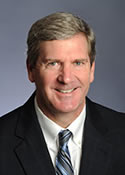Injuries to the inferior alveolar and lingual nerve continued to be a significant source of litigation for the dental professional. Approximately 10% of cases of dental malpractice are a result of nerve injury. Perhaps the genesis of the high number of lawsuits proportional to the overall number of surgeries lies in the sequelae of a nerve injury. The sequelae can range from relatively minor annoying numbness to intractable pain and the anesthesia to the area of the nerve supply.
The inferior alveolar nerve is the third division of the fifth cranial nerve. Its afferent fibers enter the mandible on lingual side and traverse the mandible distally to exit at the mental foramen. The inferior alveolar nerve is the sensory nerve responsible for carrying sensation (pressure, proprioception, pain) to the brain. It is a polyfascicular nerve in composition. While in the mandible an artery and vein accompany the polyfascicular nerve to constitute the neurovascular sheath.
The lingual nerve is a branch of the mandibular division of the trigeminal nerve which supplies sensory innervation to the tongue. It also carries fibers from the facial nerve return taste information from the anterior two thirds of the tongue. It is a single fascicle nerve whose pathway to the tongue varies.
Nerve injuries may occur when the surgeon removes teeth, places a dental implant, performs orthognathic surgery, or repairs a fractured mandible. The degree of a nerve injury is often classified according to Seddon as Neuropraxia, Axonotomesis, and Neurotomesis. In general, the more severe the trauma, the more severe the nerve injury.
Prognosis for recovery of a nerve injury depends on many factors: Age of the patient, degree of nerve injury, time between injury and repair, vascularity of the neurovascular bundle, and presence or absence of pain. In general, younger patients who have had less traumatic injuries or injuries that are timely addressed (less than six months) have far greater potential for successful recovery in neurosensory functions than older patients who have more traumatic injuries and experience a delay (greater than six months) between injury and repair.
When nerve injury is suspected, the dental professional must attend closely to the patient to monitor the progress (or lack thereof) of the nerve injury. Appropriate and accurate documentation of the surgery must be done. Follow-up should occur weekly or biweekly to assess the neurosensory function. Assessment should include a detailed mapping of the patients' condition upon each visit including, but not limited to the presence or absence of pain, the area of neurosensory dysfunction, two-point discrimination, point localization, and brush stroke direction detection.
Indications for referral to the appropriate doctor (usually an oromaxillofacial surgeon) who sub-specializes in nerve injury must take place if:
- Observed nerve injury.
- Highly suspected injury without improvement in three months.
- Brisk bleeding without improvement within three months.
- Persistent unexplained pain for greater than three months.
- Persistent anesthesia, allodynia, dysesthesia without improvement for three months.
Waiting and watching as the patient loses the opportunity and ability to recover some or all neurosensory function is not an option. If the surgeon witness or suspects an nerve injury prompt referral is important. If the patient condition leads one to suspect a nerve injury prompt referral is important.
Dr. Lee (Mac) Whitesides, DDS, MMS is Board Certified in Oral & Maxillofacial Surgery. Dr. Whitesides is one of only two oral-maxillofacial surgeons in the United States who currently hold a Masters degree in Anesthesia and Oral Surgery. He has extensive experience with Distraction Osteogenesis for the Maxillofacial Skeleton, generating sufficient quantity of bone height and width to provide the appropriate foundation for Dental Implants.
©Copyright - All Rights Reserved
DO NOT REPRODUCE WITHOUT WRITTEN PERMISSION BY AUTHOR.









